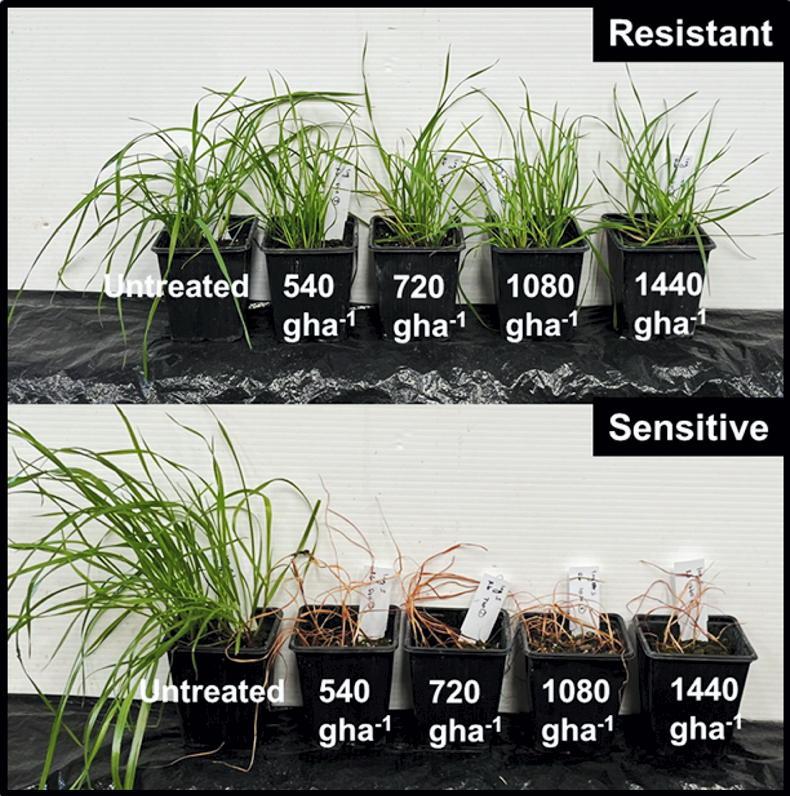Speaking to the Irish Farmers Journal, Teagasc researcher Vijaya Bhaskar has answered some questions on glyphosate resistance.
He said that while Italian ryregrass has been a threat to tillage farmers, that threat is now increasing.
He commented that glyphosate has been taken for granted in Ireland and it needs to be protected, as it is a critical part of integrated weed management plans.
How did you confirm glyphosate resistance in this Italian ryegrass?
"The agronomist and grower observed the ineffective control where glyphosate was used pre-sowing and took the initiative to reach out to us in Oak Park.
"They collected and submitted the seed samples for testing. The seeds were grown and tested with three different glyphosate products (two proprietary and one generic) at four application rates (540, 720, 1080, and 1440g/ha).
"None of the products were effective, even at the highest allowed rate. Molecular analysis revealed a known target-site mutation at the EPSPS Pro-106-Ser position, which is associated with glyphosate resistance."
Is glyphosate prone to resistance development?
"Since the late 1990s, 375 glyphosate resistance cases across more than 50 species have been reported worldwide, more commonly in orchards and vineyards.

Symptoms of glyphosate-resistant and glyphosate-sensitive populations of Italian ryegrass following application of glyphosate. Both populations were treated with dose rates from 540 g ha-1 to 1440 g ha-1 (maximum rate allowed in any single year).
"Glyphosate-resistant Italian ryegrass has been found in cereal crops in Italy and the UK, where glyphosate was repeatedly applied at low rates or to surviving plants with minimal in-crop herbicide use."
What causes resistance to develop?
"[It develops] where glyphosate is continuously relied upon as the sole control measure without sufficient cultivation, rotations and the use of in-crop herbicide options.
"It also occurs where insufficient glyphosate rates are repeatedly used or glyphosate is applied when weed growth is poor or glyphosate is applied incorrectly."
How does Teagasc investigate specific cases of herbicide resistance development?
"Teagasc evaluates each sample received by conducting glasshouse herbicide screening with the recommended rate of herbicide used plus dose-response tests as well.
"These are then followed by genetic analysis to confirm the type of resistance evolving, which helps us understand the resistance pattern.
"It should be noted that in the glasshouse conditions for the spray to work are almost optimum."
Is the Italian ryegrass that developed resistance a weed plant or do you think it came from propagated seed?
"Most weedy Italian ryegrass populations are diploid. Our ploidy analysis confirms that this resistant strain is of the weedy grass type."
Has the resistant Italian ryegrass been contained to that area?
"The farmer and the adviser have already taken on-farm biosecurity measures to contain the problem on that farm. This is the most important measure."
Speaking to the Irish Farmers Journal, Teagasc researcher Vijaya Bhaskar has answered some questions on glyphosate resistance.
He said that while Italian ryregrass has been a threat to tillage farmers, that threat is now increasing.
He commented that glyphosate has been taken for granted in Ireland and it needs to be protected, as it is a critical part of integrated weed management plans.
How did you confirm glyphosate resistance in this Italian ryegrass?
"The agronomist and grower observed the ineffective control where glyphosate was used pre-sowing and took the initiative to reach out to us in Oak Park.
"They collected and submitted the seed samples for testing. The seeds were grown and tested with three different glyphosate products (two proprietary and one generic) at four application rates (540, 720, 1080, and 1440g/ha).
"None of the products were effective, even at the highest allowed rate. Molecular analysis revealed a known target-site mutation at the EPSPS Pro-106-Ser position, which is associated with glyphosate resistance."
Is glyphosate prone to resistance development?
"Since the late 1990s, 375 glyphosate resistance cases across more than 50 species have been reported worldwide, more commonly in orchards and vineyards.

Symptoms of glyphosate-resistant and glyphosate-sensitive populations of Italian ryegrass following application of glyphosate. Both populations were treated with dose rates from 540 g ha-1 to 1440 g ha-1 (maximum rate allowed in any single year).
"Glyphosate-resistant Italian ryegrass has been found in cereal crops in Italy and the UK, where glyphosate was repeatedly applied at low rates or to surviving plants with minimal in-crop herbicide use."
What causes resistance to develop?
"[It develops] where glyphosate is continuously relied upon as the sole control measure without sufficient cultivation, rotations and the use of in-crop herbicide options.
"It also occurs where insufficient glyphosate rates are repeatedly used or glyphosate is applied when weed growth is poor or glyphosate is applied incorrectly."
How does Teagasc investigate specific cases of herbicide resistance development?
"Teagasc evaluates each sample received by conducting glasshouse herbicide screening with the recommended rate of herbicide used plus dose-response tests as well.
"These are then followed by genetic analysis to confirm the type of resistance evolving, which helps us understand the resistance pattern.
"It should be noted that in the glasshouse conditions for the spray to work are almost optimum."
Is the Italian ryegrass that developed resistance a weed plant or do you think it came from propagated seed?
"Most weedy Italian ryegrass populations are diploid. Our ploidy analysis confirms that this resistant strain is of the weedy grass type."
Has the resistant Italian ryegrass been contained to that area?
"The farmer and the adviser have already taken on-farm biosecurity measures to contain the problem on that farm. This is the most important measure."








 This is a subscriber-only article
This is a subscriber-only article









SHARING OPTIONS: